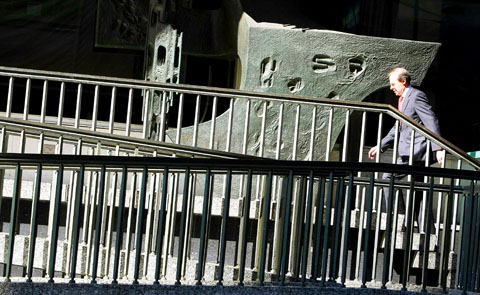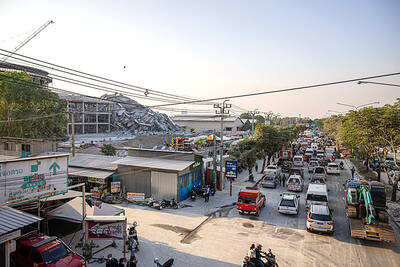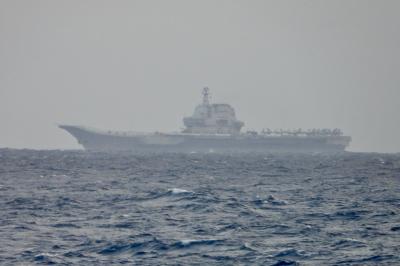Australia’s central bank cut its official interest rate by a bigger-than-expected 1 percentage point yesterday to ease credit concerns amid global financial turmoil, cheering investors around the region.
The cut to 6 percent was the largest by the Reserve Bank of Australia (RBA) since May 1992. Analysts had expected the RBA to drop the rate by half a percentage point.
Australian stocks climbed into positive territory after opening sharply lower. Other Asian markets gained after the move as well.

PHOTO: AFP
RBA Governor Glenn Stevens said in a statement that the central bank had judged that a large cut in the cash rate was needed after studying the outlook for global growth and its likely effect on Australia.
“Conditions in international financial markets took a significant turn for the worse in September,” Stevens said. “Large-scale financial failures in several major countries were accompanied by serious dislocation in interbank markets and heightened instability in other markets, including sharp falls in share prices.”
He also referred to evidence of “a significant moderation in growth in Australia’s trading partners in Asia.”
Stevens said financing around the world would be difficult for “some time” and said that Australia was affected less than other countries “given the relative strength of the local banking system.”
The move follows a quarter-point reduction last month that was the first decrease in nearly seven years.
Investors responded to the move immediately, lifting Australia’s benchmark S&P/ASX-200 index nearly 2 percent to 4,628.9 in the hour after the announcement.
Australian Prime Minister Kevin Rudd said the decision would help maintain the stability of the financial system and see Australia through “tough times ahead.”
It was not immediately clear whether banks would pass on the rate cut to their customers.
Saul Eslake, chief economist with ANZ Banking Group Ltd, welcomed the cut as “extraordinary and bold.”
“They are clearly very concerned about the financial crisis and its potential impact on global growth, on Asian economies which they specifically mention and on commodity prices,” Eslake said. “I think it will be seen firstly as contributing to the health of the financial system and a big step to reducing the downside risks to economic growth, provided it isn’t interpreted as panic.”
The cut came even though inflation is at 4.5 percent, well above the RBA’s target range of between 2 percent and 3 percent.
INDONESIA
Separately, Indonesia’s central bank raised its benchmark interest rate 25 basis points to 9.50 percent yesterday, signaling its commitment to fight inflation at the risk of slower growth, officials said.
The move would also bolster the rupiah, which fell to 9,740 against the dollar in early trade yesterday, its lowest level since January 2006, before recouping some losses to 9,640 on suspected bank intervention.
Bank Indonesia Governor Boediono told Dow Jones Newswires he remained “alert but not worried” over the rupiah’s weakness.
Inflation soared to 12.14 percent year-on-year last month from 11.85 percent in August, driven by resilient domestic demand and higher global commodity and fuel prices.
JAPAN
Meanwhile, Japan’s central bank left its key interest rate unchanged yesterday amid heightened anxiety that the US credit crisis was quickly spreading from Wall Street to Europe and beyond.
In a widely expected decision, the Bank of Japan voted unanimously to maintain the uncollateralized overnight call rate at 0.5 percent for the 20th straight month, citing a “sluggish” economy along with high inflation rates.
“With regard to risk factors, strains in global financial markets have intensified in the wake of failures and rescues of US and European financial institutions and there are downside risks to the world economy,” the central bank said in a statement.
“In addition, weaker income generation reflecting earlier deterioration in the terms of trade could potentially weigh on domestic private demand,” the bank said.
Bank Governor Masaaki Shirakawa said yesterday that central banks should set monetary policy based on conditions in their own economies, playing down the chances of coordinated interest rate cuts.
Joint action may result in one country doing something that is not favorable for its own economy, he told a press conference.
“Each country will make its own decision considering its own conditions,” he said.
Finance chiefs from the G7 nations are scheduled to meet on Friday in Washington.

AIR SUPPORT: The Ministry of National Defense thanked the US for the delivery, adding that it was an indicator of the White House’s commitment to the Taiwan Relations Act Deputy Minister of National Defense Po Horng-huei (柏鴻輝) and Representative to the US Alexander Yui on Friday attended a delivery ceremony for the first of Taiwan’s long-awaited 66 F-16C/D Block 70 jets at a Lockheed Martin Corp factory in Greenville, South Carolina. “We are so proud to be the global home of the F-16 and to support Taiwan’s air defense capabilities,” US Representative William Timmons wrote on X, alongside a photograph of Taiwanese and US officials at the event. The F-16C/D Block 70 jets Taiwan ordered have the same capabilities as aircraft that had been upgraded to F-16Vs. The batch of Lockheed Martin

GRIDLOCK: The National Fire Agency’s Special Search and Rescue team is on standby to travel to the countries to help out with the rescue effort A powerful earthquake rocked Myanmar and neighboring Thailand yesterday, killing at least three people in Bangkok and burying dozens when a high-rise building under construction collapsed. Footage shared on social media from Myanmar’s second-largest city showed widespread destruction, raising fears that many were trapped under the rubble or killed. The magnitude 7.7 earthquake, with an epicenter near Mandalay in Myanmar, struck at midday and was followed by a strong magnitude 6.4 aftershock. The extent of death, injury and destruction — especially in Myanmar, which is embroiled in a civil war and where information is tightly controlled at the best of times —

China's military today said it began joint army, navy and rocket force exercises around Taiwan to "serve as a stern warning and powerful deterrent against Taiwanese independence," calling President William Lai (賴清德) a "parasite." The exercises come after Lai called Beijing a "foreign hostile force" last month. More than 10 Chinese military ships approached close to Taiwan's 24 nautical mile (44.4km) contiguous zone this morning and Taiwan sent its own warships to respond, two senior Taiwanese officials said. Taiwan has not yet detected any live fire by the Chinese military so far, one of the officials said. The drills took place after US Secretary

THUGGISH BEHAVIOR: Encouraging people to report independence supporters is another intimidation tactic that threatens cross-strait peace, the state department said China setting up an online system for reporting “Taiwanese independence” advocates is an “irresponsible and reprehensible” act, a US government spokesperson said on Friday. “China’s call for private individuals to report on alleged ‘persecution or suppression’ by supposed ‘Taiwan independence henchmen and accomplices’ is irresponsible and reprehensible,” an unnamed US Department of State spokesperson told the Central News Agency in an e-mail. The move is part of Beijing’s “intimidation campaign” against Taiwan and its supporters, and is “threatening free speech around the world, destabilizing the Indo-Pacific region, and deliberately eroding the cross-strait status quo,” the spokesperson said. The Chinese Communist Party’s “threats